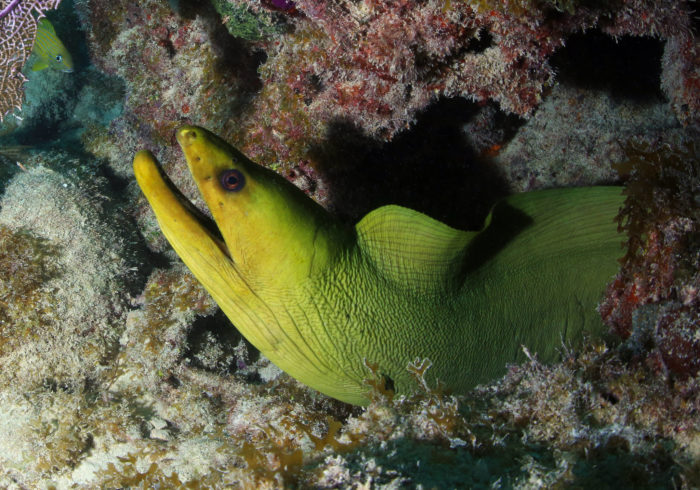
Sea Wonder: Green Moray Eel
The green moray eel is a mysterious animal that defies expectations. For example, you might think it’s a serpent but it’s actually a fish. You might think it’s green because of its name, but it’s actually brown and covered with yellow mucus. Learn more about this sea wonder below!
Appearance
The green moray eel (Gymnothorax funebris) is one of the largest in the moray family reaching lengths of up to eight feet and weighing up to 65 pounds! Its long body is compressed laterally, meaning its sides are fairly flat. It has a dorsal fin on its back that spans from right behind its head all the way to the end of the body where it fuses with the tail fins. Unlike other fish, the green moray eel does not have pectoral or pelvic fins. To make up for it, they are the only fish that can swim both forward and backwards.
Its skin lacks scales and we wouldn’t blame you if you thought it was truly green in color. In fact, the green moray eel has brown skin covered all over with a thick, yellow mucus that protects it from parasites and disease. Against the dark backdrop of its habitat, this creates the illusion of a green skin. It has several sharp teeth in the front of its mouth, two nostrils on the front of its face, an eye on either side of its head, and gills that take the form of two circular openings behind the head.
Diet and Habitat
Green moray eels live in shallower along the western Atlantic Ocean. They span from New Jersey all the way south to Brazil and into the Gulf of Mexico, which means we can see them in Flower Garden Banks, Florida Keys, Gray’s Reef, and Monitor national marine sanctuaries. They prefer habitats that provide lots of tiny crevices in which they can hide, including rocky shorelines, coral reef communities, mangrove forests, and occasionally in seagrass beds. They generally call waters shallower than 100 feet deep home due to the fact that this where their prey species live.
The green moray eel falls on the lazier end of the predator scale as it utilizes a sedentary hunting strategy. This means, it usually waits for the crabs, fish, shrimp, and cephalopods that comprise its diet to come to the eel’s hiding place where they then meet their fate. Sometimes, usually at night, green moray eels will leave their hiding spots to seek out food, which they use their strong sense of smell to locate. To feed, the eel will quickly grab its target and swallow it whole. These fish have few, if any, natural predators.
If you see an eel while diving or at an aquarium that house them, and it has its teeth showing, it’s not a threatening gesture – this is just how they move water in and out of their mouths.
Life History
Green moray eels begin their lives as larvae that hatch from extremely small eggs about 1 millimeter in diameter. These ribbon-shaped larvae (called leptocephali) drift among the water column where they feed (and are often preyed upon) and float until they are ready to enter their next life stage, which is usually around eight months old. Once they enter their juvenile stage, they settle into a new habitat where they feed and grow into adult eels that can live between six and 36 years. Adult eels are fairly solitary animals and they breed by spawning, but not much is known about the reproductive cycles or behaviors of this species.
Threats and Conservation
The green moray eel is not considered threatened or endangered and is common throughout its range. This is partially due to the fact that they are not generally safe for humans to eat and are not fished. However, their habitats and prey species are under increasing pressure from things like climate change, habitat degradation, ocean acidification, plastics pollution, overfishing, and bycatch. We can protect green moray eels and their ecosystems by doing our part to reduce our consumption and waste, taking action against threats like climate change, and making responsible seafood choices that support responsible fishing practices.

